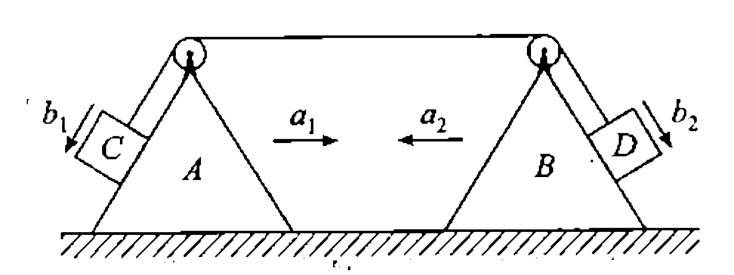Let a1&a2 are the acceleration of A & B. Let b1&b2 the acceleration of C & D relative to the wedges A and B respectively, choose the right relation. (directions of a1,a2,b1&b2 are shown in figure below) :

a1−a2+b1−b2=0
a1+a2−b1−b2=0
a1+a2+b1+b2=0
a1+b2=a2+b1
The correct Answer is:B
Step by step video, text & image solution for Let a_(1) & a_(2) are the acceleration of A & B. Let b_(1) & b_(2) the acceleration of C & D relative to the wedges A and B respectively, choose the right relation. (directions of a_(1), a_(2), b_(1) & b_(2) are shown in figure below) : by Physics experts to help you in doubts & scoring excellent marks in Class 11 exams.
Updated on:21/07/2023Topper's Solved these Questions
- NEWTONS LAWS OF MOTIONBOOK - PHYSICS GALAXY - ASHISH ARORACHAPTER - NEWTONS LAWS OF MOTIONEXERCISE - Numerical MCQs
90 Videos
- NEWTONS LAWS OF MOTIONBOOK - PHYSICS GALAXY - ASHISH ARORACHAPTER - NEWTONS LAWS OF MOTIONEXERCISE - Advance MCQs
17 Videos
- NEWTONS LAWS OF MOTIONBOOK - PHYSICS GALAXY - ASHISH ARORACHAPTER - NEWTONS LAWS OF MOTIONEXERCISE - Discussion Question
39 Videos
- LINEAR MOMENTUM & ITS CONSERVATIONBOOK - PHYSICS GALAXY - ASHISH ARORACHAPTER - LINEAR MOMENTUM & ITS CONSERVATIONEXERCISE - exercise 1.3
3 Videos
- RIGID BODIES AND ROTATIONAL MOTIONBOOK - PHYSICS GALAXY - ASHISH ARORACHAPTER - RIGID BODIES AND ROTATIONAL MOTIONEXERCISE - Unsolved Numerical
63 Videos
Similar Questions
Knowledge Check
Let →a1 and →a2 are the acceleration of wedges A and B. Let →b1 and →b1 be the accelerations of C and D relative to wedges A and B respectively. Choose the right relation :
 A→a1−→a2+→b1−→b2=0B→a1+→a2+→b1+→b2=0C→a1+→a2−→b1−→b2=0D→a1+2→b2=2→a2−→b1=0
A→a1−→a2+→b1−→b2=0B→a1+→a2+→b1+→b2=0C→a1+→a2−→b1−→b2=0D→a1+2→b2=2→a2−→b1=0If the equation of the locus of a point equidistant from the points (a1,b1, and (a2,b2) is
(a1−a2)x+(b1−b2)y+c=0, then the value of c isA12(a22+b22)−(a21−b21)B(a21−a22+b21−b22)C12(a21+a22+b21+b22)D√(a21+b21−a22−b22)Let a1,a2,…. and b1,b2,…. be arithemetic progression such that a1=25, b1=75 and a100+b100=100, then the sum of first hundred term of the progressiona1+b1, a2+b2,…. is equal to
A1000B100000C10000D24000
Let a,b,c,d,a∈R and satify the relations a(b−c)2+a1bc=c−0anda(b+c1)2+a2bc1+c=1 then which is true
View SolutionIf the equation of the locus of a point equidistant from the points (a1,b1) and (a2,b2) is (a1−a2)x+(b1−b2)y+c=0 , then the value of c is
View SolutionIf the equation of the locus of a point equidistant from the points (a1,b1) and (a2,b2) is (a1−a2)x+(b1−b2)y+c=0, then the value of 'c' is:
View SolutionIf the equation of the locus of a point equidistant from the points (a1,b1) and (a2,b2) is (a−1−a2)x+(b1−b2)y+c=0 , then the value of c is
View SolutionIf the equation (a1−a2)x+(b1−b2)y=c represents the perpendicular bisector of the segment joining (a1,b1)(a2,b2), then 2c=
View Solution
